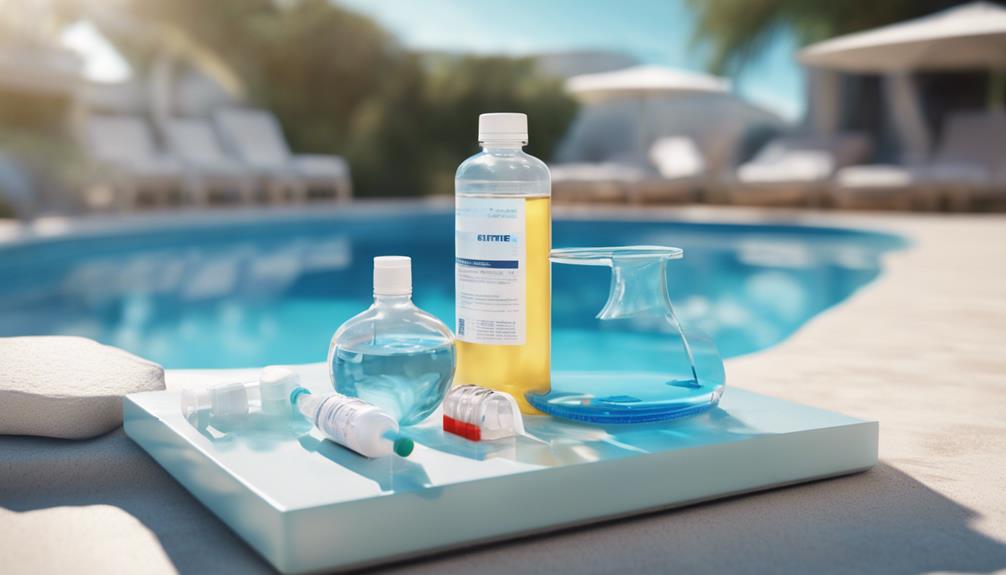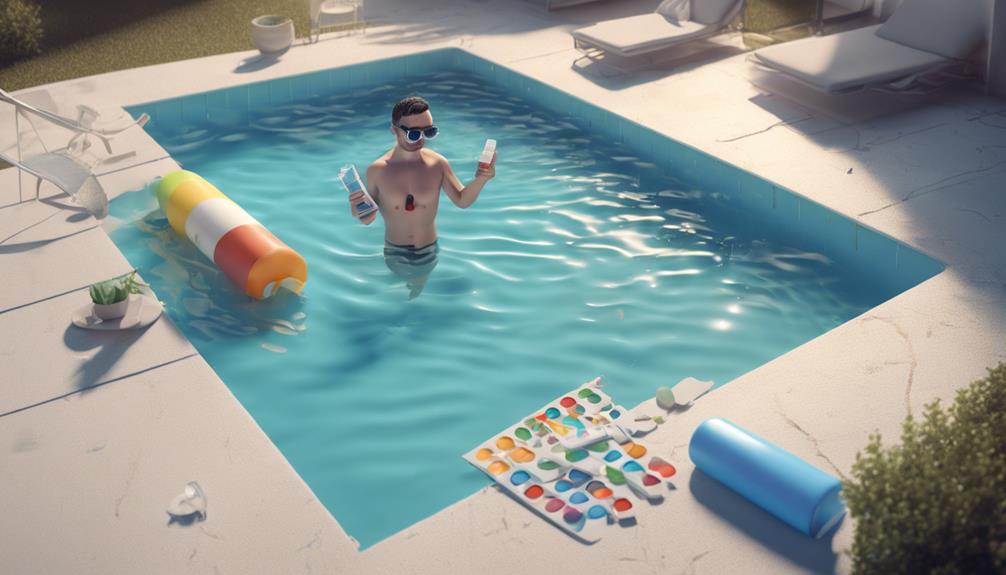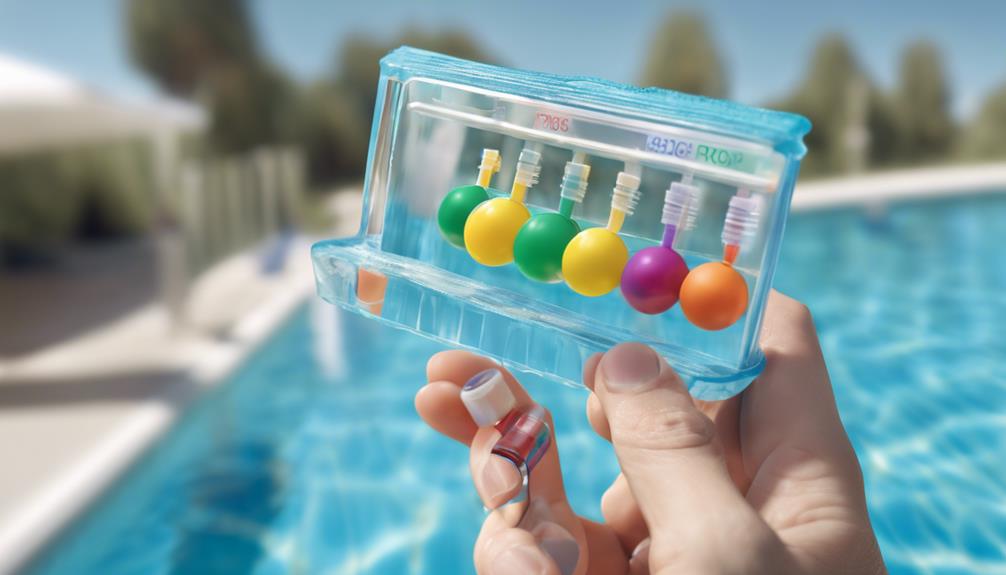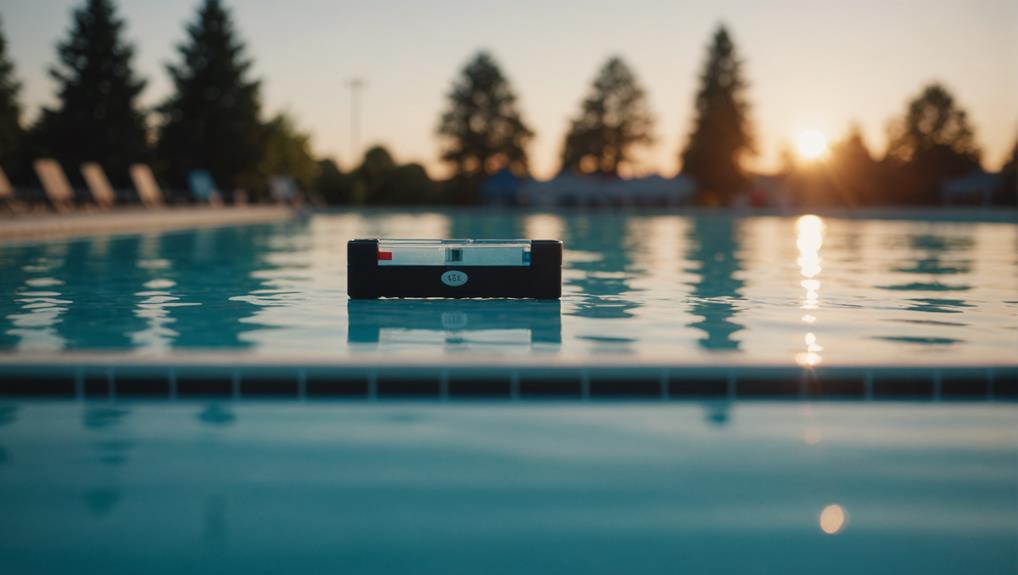You can test your pool water chlorine levels using various methods, each with its own level of convenience, accuracy, and thoroughness. Pool test strips provide a quick snapshot of key parameters, including total hardness, total chlorine, and pH. For more accurate results, consider using pool kits like DPD or OTO-Phenol tests. Liquid test kits and digital water testers offer precise readings, while digital testers can measure multiple parameters. Regular testing helps maintain a balanced and healthy pool environment. To confirm you're getting it right, explore the different testing methods and discover the best approach for your pool's unique needs.
Key Takeaways
- Using pool test strips provides a quick and easy way to measure chlorine levels, with results available in seconds.
- Accurate chlorine readings can be achieved with pool test kits, such as DPD or OTO-Phenol kits, which measure multiple parameters.
- Digital water testers offer precise readings for multiple parameters, including chlorine levels, pH, and alkalinity, at a higher cost.
- Liquid testing provides accurate results for chlorine levels, with options ranging from affordable to high-end test kits.
- Regular testing of chlorine levels, at least 2-3 times a week, is essential to maintain a safe and healthy pool environment.
Understanding Pool Water Testing
When it comes to maintaining a safe and healthy pool environment, understanding pool water testing is essential, as it allows you to monitor and adjust the chemical parameters that impact water quality and swimmer safety.
Testing your pool water regularly is pivotal to guarantee a balanced chemical environment, which is necessary for a great pool experience. You'll want to test for free chlorine levels, pH, total alkalinity, and calcium hardness, as these parameters affect the overall water chemistry.
Pool test kits are available to help you measure these levels, and they come in different types, such as DPD and OTO-Phenol tests.
To maintain a proper chemical balance, you should test your pool water at least once a week, or more often if the pool is heavily used or during weather changes. By doing so, you'll be able to identify any issues and make adjustments to your pool maintenance routine accordingly.
Using Pool Test Strips Effectively
You can quickly and easily measure key pool water parameters, including total hardness, total chlorine, free available chlorine, pH, total alkalinity, and stability, using pool test strips.
To test pool water with a strip, simply remove one from the bottle, dip it into the pool at elbow depth, and compare the results to the provided chart.
This will give you a snapshot of your pool's chemical levels, allowing you to adjust your pool chemicals accordingly.
The test strip container may also provide general guidelines on balancing chemical levels, making it a user-friendly option for pool owners.
While test strips are economical, simple to use, and easy to read, they do have a marginal level of accuracy compared to liquid test kits.
However, they're perfect for quick and easy daily or weekly testing.
By using pool test strips effectively, you can certify your pool water is safe and healthy for swimmers, and maintain the right pH level and total chlorine levels.
Regular pool water testing with test strips can also help you identify any issues before they become major problems.
Accurate Testing With Pool Kits

When you choose a pool test kit, you'll find that you have several options to suit your needs, including 2-in-1, 5-in-1, and 6-in-1 kits, as well as liquid reagent kits and test strips.
You'll want to select a kit that provides accurate chlorine readings, as this is vital for maintaining a safe and healthy pool environment.
Pool Test Kit Options
Accurate chlorine level readings rely on selecting the right pool test kit from the various options available, each offering a range of testing capabilities and degrees of precision. When choosing a pool test kit, you'll come across DPD Test Kits and OTO-Phenol kits. DPD tests usually measure chlorine, pH, alkalinity, stabilizer, and hardness, while OTO-Phenol kits test for chlorine and pH, offering a range of options for pool owners.
| Kit Type | Parameters Tested | Accuracy |
|---|---|---|
| DPD Test Kit | Chlorine, pH, Alkalinity, Stabilizer, Hardness | High |
| OTO-Phenol Kit | Chlorine, pH | Moderate |
| Liquid Test Kit | Chlorine, pH, Alkalinity, Calcium Hardness, Cyanuric Acid | High |
| Test Strips | Chlorine, pH | Low |
| Combo Kit | Chlorine, pH, Alkalinity, Calcium Hardness, Cyanuric Acid, Stabilizer | High |
To get the best out of your pool test kit, make sure to follow the instructions carefully and choose a kit that measures all five main water balance levels. Liquid drop-style pool test kits provide more accurate results than test strips, making them a popular choice among pool owners who prioritize precise chlorine level readings. By selecting the right pool test kit, you'll be able to test your pool water accurately and take the necessary steps to maintain ideal chlorine levels.
Accurate Chlorine Readings
By following the manufacturer's instructions and using the correct test kit, pool owners can obtain reliable chlorine readings, ensuring their pool water is safe and healthy for swimmers.
You'll want to choose a kit that includes a chlorine test, as well as pH and alkalinity tests, to get a thorough picture of your pool's chemical levels.
When testing, make sure to follow the kit's instructions for collecting and preparing the water sample. This typically involves filling a small container with pool water and adding a reagent to trigger a color change. Compare the resulting color to the kit's reference chart to determine the chlorine level.
Vital to test chlorine levels at the same time every day, as levels can fluctuate depending on factors like sunlight and bather load.
Accurate testing is vital, as incorrect readings can lead to inadequate sanitizing, putting swimmers at risk.
Measuring Chlorine and Ph Levels
You'll need to measure chlorine and pH levels regularly to guarantee your pool water remains safe and healthy. To do this, you can use pool test strips or pool testing kits, which measure chlorine and pH levels, as well as total alkalinity and total hardness. When choosing a kit or strips, look for ones that measure these four essential chemical readings.
| Parameter | Ideal Range | Frequency |
|---|---|---|
| Free Chlorine | 1-4 ppm | 2-3 times a week |
| pH | 7.2-7.6 | 2-3 times a week |
| Total Alkalinity | 80-120 ppm | 1-2 times a week |
| Total Hardness | 200-400 ppm | 1-2 times a week |
When testing pool water with a strip, simply remove one from the bottle, dip it into the pool at elbow depth, and compare the results to the provided chart. Remember, the ideal chlorine level is between 1 and 3 parts per million (ppm), and chlorine levels can fluctuate due to factors like weather, bather load, and water chemistry. By regularly measuring chlorine and pH levels, you'll be able to maintain a balanced and healthy pool environment.
When to Test Your Pool Water

To guarantee your pool water remains safe and healthy, it's vital to establish a regular testing schedule, taking into account various factors that can impact chlorine levels and overall water chemistry.
As a pool owner, you should test your pool water's free chlorine levels 2-3 times a week, verifying they fall within the ideal range of 1-4 ppm. However, if your pool is frequently used, you may need to test 4-5 times a week to maintain effective sanitizer levels.
Additionally, consider testing before and after a pool party to account for increased usage and potential contamination. After a storm, test your pool water's free chlorine and pH as soon as possible to confirm the water remains safe and balanced.
During peak season, regular testing is essential to maintain a balanced pool environment, and you may need to test every few days. By testing at these critical times, you'll be able to identify any issues with your pool equipment or water chemistry and make adjustments to keep your pool water safe and healthy.
Benefits of Regular Chlorine Testing
When you test your pool water's chlorine levels regularly, you'll be able to identify and respond to fluctuations that can impact the water's safety and quality.
You'll also guarantee the accuracy of your readings, which is critical since even slight deviations can have significant consequences.
Chlorine Level Fluctuations
Fluctuations in chlorine levels can occur frequently, especially in pools with high bather loads or inconsistent sanitizer application, which is why regular testing is crucial to maintaining a safe and healthy swimming environment.
You should test your pool water chlorine levels daily, or at least every other day, to confirm they remain within the ideal range of 1-3 parts per million (ppm).
You can use a chlorine test kit to collect a sample of your pool water and analyze its pH level. If the pH is too high or too low, it can affect the efficacy of your sanitizing chemicals, leading to fluctuations in chlorine levels.
To achieve accurate results, add the testing chemicals to the sample according to the kit's instructions. Then, compare the color of the sample to the chart provided to determine the chlorine level.
Regular testing helps you identify and address any issues promptly, confirming your pool water remains clean, clear, and safe for swimmers.
Importance of Accuracy
By regularly testing your pool water's chlorine levels, you'll be able to pinpoint even slight deviations from the ideal range, guaranteeing a consistently safe and healthy swimming environment.
Accurate testing is vital, as it allows you to adjust the chlorine dosage accordingly, maintaining the perfect balance for peak water quality.
If you don't know how to test your pool water's pH levels, mastering this skill is imperative, as pH imbalances can affect chlorine's effectiveness.
You need to test your pool water frequently to guarantee the chlorine levels are within the recommended range.
When you add chemicals, make sure you're using the appropriate amount, as over- or under-chlorination can have adverse effects.
A dosage chart can be a helpful reference to guarantee you're adding the correct amount.
Remember, it only takes one drop of chlorine to make a significant difference in your pool's water quality.
Choosing the Right Test Method

You'll need to select a reliable testing method to guarantee accurate chlorine level readings, as different approaches vary in convenience, accuracy, and thoroughness.
When it comes to measuring chlorine levels in your pool water, you have several options to choose from, each with its pros and cons.
Convenience vs. Accuracy: Do you prioritize speed and ease of use or precise results? Test strips are quick but may not be as accurate, while digital water testers provide precise readings but are often more expensive.
In-Depth Testing: Do you need to test for just chlorine levels or other parameters like pH, alkalinity, and hardness? DPD tests and OTO-Phenol kits offer more in-depth testing, while liquid testing provides accurate results for chlorine levels.
Cost-Effectiveness: Are you willing to invest in a high-end digital water tester or opt for a more affordable test kit or test strips?
Frequently Asked Questions
What Is the Most Accurate Way to Test Chlorine in a Pool?
You'll achieve the most accurate chlorine testing results by using a digital water tester, which provides precise readings of free chlorine and total chlorine, unlike chlorine tablets, liquid chlorine, or chlorine granules, which can be affected by various factors.
How Do I Check the Chlorine Level in My Pool?
When you're unsure about your pool's chlorine level, like Sarah who noticed cloudy water after a heavy rainfall, you can check it using test strips or a pool test kit, ensuring water safety and proper pool maintenance.
What Is the Best Way to Test Water for Chlorine?
When you test water for chlorine, you're ensuring pool chemistry is balanced for swimming safety and sanitation. You can opt for chlorine test strips, but for precise readings, consider liquid kits or digital testers to maintain ideal chlorine levels and residuals for superior water quality.
What Is the Easiest Way to Test Pool Water?
You're the captain of your pool's chemistry, ensuring water safety with quick tests, and home methods like DIY kits, color charts, or digital meters. For a speedy check, you'll find test strips are the anchor that holds it all together.
Conclusion
You've got the tools to guarantee your pool water is safe and healthy.
Regular chlorine testing is vital to prevent eye and skin irritation, as well as the spread of waterborne illnesses.
Take the case of Emily, who suffered a severe ear infection from swimming in an improperly sanitized pool.
Don't let this happen to you or your loved ones – test your pool water chlorine levels regularly to guarantee a fun and healthy summer.

I’m Max, the founder and chief pool enthusiast behind Pool Pro Tips. As a passionate pool owner and cleaning expert, I created this website to share my knowledge and experience with you, helping you to keep your pool sparkling clean and safe for years to come.

